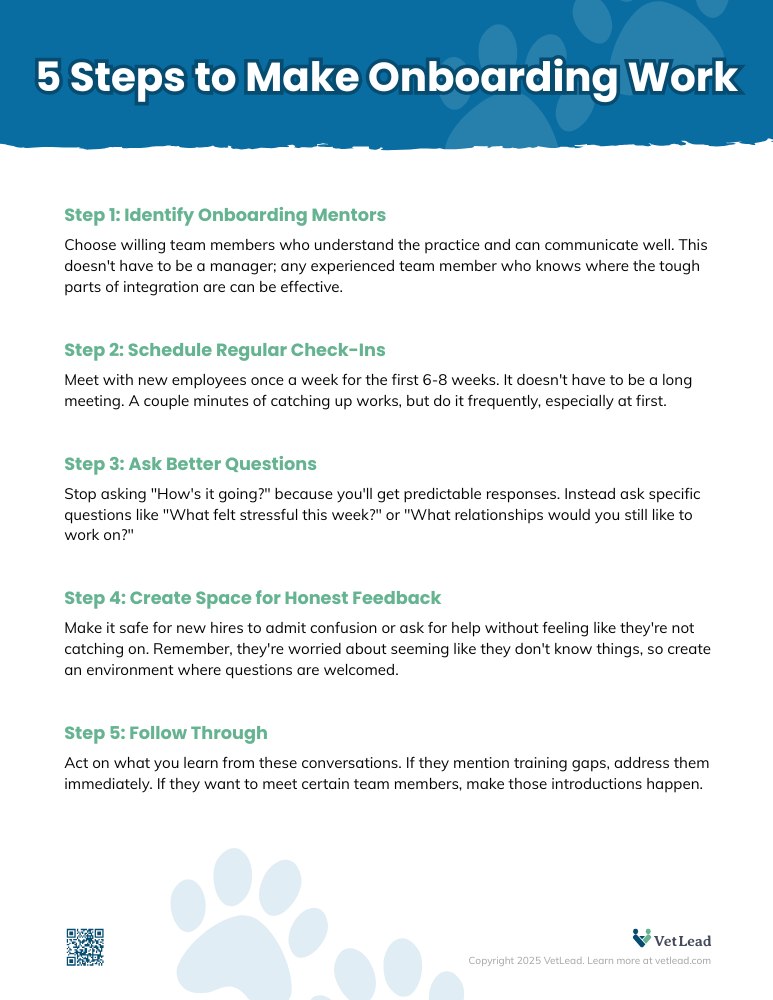If you're dealing with high turnover in your veterinary practice, then getting onboarding right isn't just nice to have. It's essential. Because here's the thing: people decide fast whether your practice feels like home or just another job.
Now, onboarding is what happens when we bring new people into our hospital. It's a little different than training, and I want you to understand why it's so important as you work to build veterinary teams where people actually want to stay and contribute.
New Hires Decide Whether to Stay Within Days
Here's what the research tells us: people make decisions relatively quickly when they enter a new practice, a new organization, a new work environment. They're asking themselves whether it's the right place for them, whether it will fit their life, whether they feel welcome and encouraged to get into the club, so to speak.
When people feel like they're integrating well, like this is their new home or their best new place, they start to engage differently in the way they work. They contribute more. They build stronger relationships with the team around them. They learn faster because there's less confusion or fear.
Think about it from their perspective. When you're brand new in an environment, taking a risk to say, "Hey, I don't understand this," or "This didn't feel comfortable" feels scary. People are generally worried about doing that. They're thinking, "I'm brand new here, I don't want to seem like I don't know things or that I'm not catching on really quickly." So they sort of pull back and wait. That creates a lot of stress as they're trying to integrate.
The Onboarding Mentor: Your Secret Weapon
One of the most powerful things we can do is assign an onboarding mentor. This is different than a trainer, although it could be the same person. It could be their manager, it could be anyone who's already here in the hospital and understands how things work or where the tough parts of integration are.
The onboarding mentor should meet with the new employee once a week or so. And it doesn't have to be a long meeting - it can be a couple of minutes of catching up - but it's good to do it frequently, especially at first.
Stop Asking New Hires "How's It Going?"

Most veterinary managers try to check in with new hires, but they often make a mistake: They ask, "How's it going?" And when we ask somebody how it's going, we know what they're going to say, usually: "It's going good, it's going fine." And we don't have any more information from that conversation that can help them do things differently or better.
That's why we need to think about a set of onboarding questions we can use. Here are the kinds of questions that actually get you somewhere.
Questions That Create Insight
Instead of generic check-ins, try these:
You don't have to ask or get an answer to every one of these questions during every meeting. But we do want to go beyond "Hey, I'm just checking in. How's it going this week?" Because that puts the burden on them to share information with you, rather than the burden on us as an organization to have a process that extracts that information in a way that lets us support them better.
Help New Hires Succeed Instead of Just Watching
Sometimes in organizations, what happens is brand new people come in and we sort of stand around and watch to see if they make it. "I wonder if they're going to make it here. Let's see if they can swim, right?" And we just sort of throw them in and observe. That's not what we want to do.
We've invested a lot of time and effort in getting the right people to our team. They're not easy to find, and we want to make sure that we support them as they are successful, not just watch and see if they are successful. We want to help them become a strong contributor, not just observe whether or not they actually do become a strong contributor.
This shift from hoping people will make it to intentionally helping them succeed is what separates practices that retain great talent from practices that constantly struggle with turnover.
Making It Work in Your Hospital
If you get to be an onboarding mentor in your hospital, think about how you do it well. How do you set up these meetings? How do you grab a few minutes on a weekly basis to have these really important conversations?
5 Steps to Make Onboarding Work in Your Practice

5 Steps to Successful Onboarding in Your Veterinary Practice
Download this free resource, share it with leaders and teams. No email address required.
If you get to be an onboarding mentor in your hospital, think about how you do it well. How do you set up these meetings? How do you grab a few minutes on a weekly basis to have these really important conversations?
5 Steps to Make Onboarding Work in Your Practice
- Identify onboarding mentors - Choose willing team members who understand the practice
- Schedule regular check-ins - Meet weekly for the first 6-8 weeks
- Use better questions - Go beyond surface-level responses
- Create space for honest feedback - Make it safe to share real challenges
- Follow through - Act on what you learn
The point is to help new team members integrate in a way that causes them to feel connected to the work that we do. When you use this process on a regular basis, you're not just hoping they'll figure it out, you're actively helping them become part of your team.
It isn’t complicated, but it is intentional. It's about showing up consistently, asking better questions, and creating space for new team members to be honest about their experience. When you do this right, you'll see people engage faster, contribute more, and stick around longer.
What do you think? Other veterinary pros want to hear from you! Share your experience in the comments below.